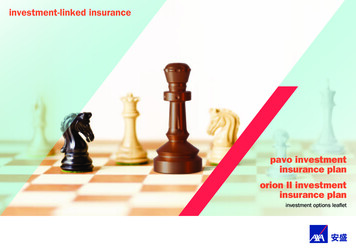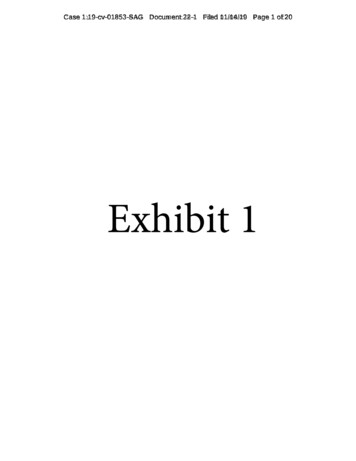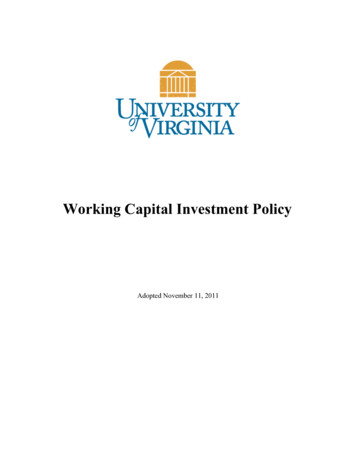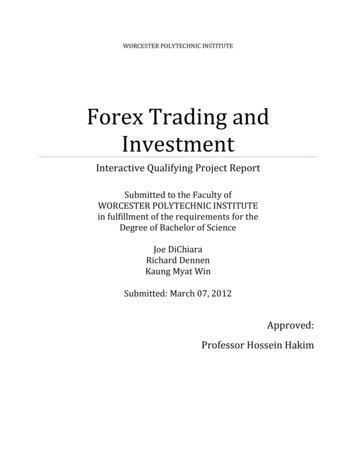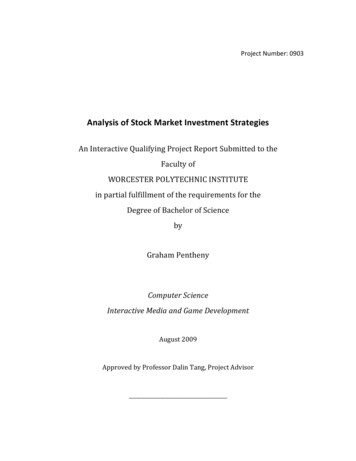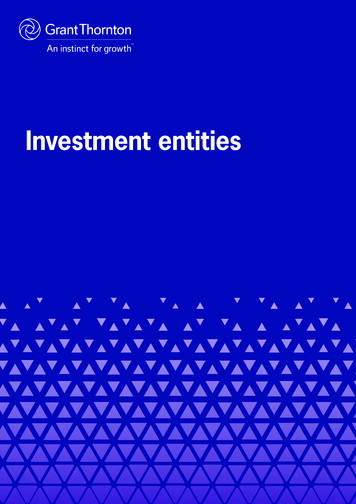
Transcription
The Case for Investment inEnterotoxigenic Escherichia coli VaccinesMarch 2011
PATH is an international, nonprofit organization that creates sustainable, culturally relevant solutions,enabling communities worldwide to break longstanding cycles of poor health. By collaborating withdiverse public- and private‑sector partners, PATH helps provide appropriate health technologies andvital strategies that change the way people think and act. PATH’s work improves global health and wellbeing.PATHPO Box 900922Seattle, WA 98109 USAPhone: 1-206.285.3500Fax: 1-206.285.6619www.path.orgBIO Ventures for Global Health is a non-profit organization whose mission is to save lives byaccelerating the development of novel biotechnology-based drugs, vaccines, and diagnostics to addressthe unmet medical needs of the developing world. The organization spurs biotech industry involvementin global health product development by increasing biotech and global health partnerships, designingand advocating for compelling market‑based incentives, and synthesizing and disseminating criticalinformation and quantitative analysis.BIO Ventures for Global Health221 Main StreetSuite 1600San Francisco, CA 94105 USAPhone/Fax: 1-415.446.9440www.bvgh.orgCopyright 2011, Program for Appropriate Technology in Health (PATH) and BIO Ventures for GlobalHealth (BVGH).All rights reserved.Funding for this publication was provided by the Bill & Melinda Gates Foundation.Cover photos: PATH/Mike Wang (far left and far right); stock images (others)
Table of ContentsExecutive Summary 1The Global Need for ETEC Vaccines 4Disease Description 6Disease Burden 6Current Methods of Prevention and Treatment 9Scientific Feasibility of an ETEC Vaccine 10Current Research and Development 12An Assessment of the ETEC Vaccine Market 14Study Rationale, Objectives, and Process 14Key Inputs 15Pricing and Market Penetration 20Distribution Channels 22Results of the Base Case 23Challenges and Opportunities 26Conclusions 30Appendix A: Current Research and Development 32Appendix B: ETEC Market Assessment Team 37Appendix C: Stakeholders Interviewed 38References 40List of AcronymsBVGHBIO Ventures for Global HealthFTAfimbrial tip adhesinsCFcolonization factorLTheat-labile toxinCFAcolonization factor antigensNATONorth Atlantic Treaty OrganizationCFUcolony forming unitORSoral rehydration solutionDALYdisability-adjusted life yearORToral rehydration therapydmLTdouble mutant heat-labile toxinR&Dresearch and developmentEPIExpanded Programme on ImmunizationSTheat-stable toxinETECenterotoxigenic Escherichia coliWHOWorld Health Organization
Wendy Stone
Executive Summarythe developing world, as well as one of the topinfectious-disease threats to military personneldeployed in ETEC-endemic countries. Recentstudies suggest that ETEC incidence among allof these populations—children in the developingworld, travelers, and the military—may be evenhigher than current estimates.6Diarrhea is the second-leading cause of deathamong children under the age of five worldwide,killing an estimated 1.5 million and hospitalizingmillions more, mostly in developing countries.1Beyond its potentially devastating and immediateimpacts on health, diarrheal disease can also havelong-term implications, including malnutritionand adverse consequences on physical andcognitive development. Infants and youngchildren in the developing world bear the bruntof death and illness from diarrheal disease,2but older children and adults in these settingsalso suffer from its symptoms and the resultingsevere, life‑threatening dehydration.3 In addition,travelers and military personnel visiting thedeveloping world are at high risk of suffering fromdiarrhea. However, these individuals usually haveaccess to immediate and sufficient health care toalleviate illness and prevent death—an option thatmany children in the developing world simply donot have. Despite this better access to care andtreatment of diarrhea, there is growing evidencethat acute illness experienced by these visitors todeveloping countries can lead to more long‑termhealth conditions, ranging from functionalgastrointestinal disorder, like irritable bowelsyndrome, to reactive arthritis in approximately10 percent of individuals recovering from anepisode of travelers’ diarrhea.4Recent studies suggest thatETEC incidence among allof these populations—children in the developing world,travelers, and the military—may be even higherthan current estimates.An effective ETEC vaccine could have a significantimpact on global health, saving the lives ofhundreds of thousands of children each year andpreventing considerable physical suffering andmalnutrition due to repeated bouts of illness.Beyond this, an ETEC vaccine could also benefitvisitors to endemic countries, saving millionsof dollars in lost productivity and acute andchronic medical costs. In addition, a vaccine maybenefit local economies in these endemic areasby providing an effective safeguard against therisk of travelers’ diarrhea, which could encouragetourism. Many prevention and treatment optionsto address diarrheal illness from ETEC existand are important parts of the solution. Globalaccess to improved sanitation and clean wateris an important long-term goal for addressingall diarrheal diseases. However, interventionslike new ETEC vaccines could play a critical andcomplementary role in many parts of the worldOne of the leading bacterial causes of diarrhea isenterotoxigenic Escherichia coli (ETEC). Bacterialpathogens are spread more easily in areas withpoor sanitation and limited access to clean water,a frequent concern in the developing world. Asa result, ETEC may be the first enteric illnessencountered by many infants and is responsiblefor an estimated 300,000 to 500,000 deaths eachyear, mostly among children.5 ETEC is also theleading cause of diarrhea among travelers to1
The Case for Investment in Enterotoxigenic Escherichia coli Vaccinesprivate markets for the public good throughimplementation of tiered pricing schemes, whichallow companies to achieve a return on investmentin profitable markets, such as the traveler andmilitary segments, while providing those productsat substantially lower cost in the developing world.where appropriate medical treatment for severediarrhea and dehydration is limited and access tosanitation and safe water is currently inadequate.In the last few years, momentum has beenbuilding in both the public and private sectorsaround research and development (R&D) effortsto develop new diarrheal disease interventions,including an ETEC vaccine. A recent report foundthat although the global share of R&D investmentcaptured by diarrheal diseases remainedapproximately the same from 2007 (4.4 percent)to 2008 (4.5 percent), the overall number oforganizations contributing to these investmentsincreased. Also during this timeframe, publicfunding for diarrheal diseases from high-incomecountry governments and multilaterals increasedIn 2006, BIO Ventures for Global Health (BVGH)developed a model to evaluate the businesscase for investment in ETEC vaccines. Themodel and resulting analysis were presented torepresentatives at several industry and globalhealth meetings and conferences. In 2008,technological advances since the first analysisand growing interest in the ETEC vaccine field ledBVGH to team with PATH to review and updatethe analysis, develop a revised product profile,and generate revised estimates of global marketdemand based on this new information.The purpose of this reportis to provide a rationale for thedevelopment of ETEC vaccines.The purpose of this report is to provide a rationalefor the development of ETEC vaccines. Specifically,we aim to increase the awareness of biotechnologyand pharmaceutical companies in Europeand the United States, as well as companies inemerging markets like China and India, about theopportunities and potential markets that exist forlow-cost and effective ETEC vaccines. In addition,we hope to provide donors and commercialinvestors with a better understanding of thepotential risks, rewards, and gaps in knowledgerelative to these opportunities as they considertheir own investment strategies.substantially, from US 43.8 million in 2007 to60.4 million in 2008 (up from 38.5 percent to45.7 percent of global funding), with innovativedeveloping-country governments contributinga further 5.2 million (3.9 percent of the globaltotal).7 In addition, at least three pharmaceutical/biotechnology companies—Intercell,8 SanofiPasteur,9 and Novartis AG10—have recently shownan interest in ETEC vaccine development. Twoof these companies have already made directinvestments in specific products, but one appearsnot to be pursuing further development. Majorphilanthropic players, including the Bill &Melinda Gates Foundation,11 the United Kingdom’sDepartment for International Development,12and the Research Council of Norway,13 have alsoannounced new investments in ETEC vaccinesover the last several years. In addition, globalagencies have made greater commitments tounderstanding diarrheal disease burden andthe impact of specific pathogens. Finally, therehave been increased opportunities to leverageThe report first provides relevant backgroundinformation for our updated assessment, includingan overview of ETEC illness, disease burden,current treatment and prevention methods, andthe scientific feasibility and current status of ETECvaccine development. We then present the marketassessment itself, detailing the key inputs used inthe analysis and resulting estimates for potentialpricing, market penetration, and revenue for eachof the markets we analyzed. Given the myriadinvestment scenarios that can arise in this market,this report focuses on the primary inputs tofinancial-return scenarios. This allows companies2
The Case for Investment in Enterotoxigenic Escherichia coli Vaccines(or sequelae) from travelers’ diarrhea also bolstersthe potential market. However, it should be notedthat it may be challenging to meet the targetproduct profile used in this assessment within thenext decade, and there are some key uncertaintiesthat affect the results of this estimate, which arefurther detailed in the report. These uncertaintiesare typical for a market assessment conductedyears in advance of an actual product and forproducts that rely on the limited epidemiologicaldata available from developing countries.and their investors to run their own scenarios toestimate net present value and internal rate ofreturn, based on their individual circumstances.Through this assessment, we found that thepotential developing-country, traveler, and militarymarkets for ETEC vaccines continued to expandsince the earlier market analysis results thatBVGH presented in 2006.14 In addition, the recentincrease in investments in ETEC vaccine R&D, aswell as encouraging technological developmentsand promising field data on the protective efficacyof ETEC vaccine candidates in travelers, mayhelp to reduce the perceived risk associated withinvestment in this technology. Our analysisdemonstrates that ETEC vaccines may representa moderate opportunity for industry investmentwith an estimated annual revenue potential ofmore than 600 million, 10 years after globallaunch. This opportunity is driven primarily bytravelers and middle-income markets (both publicand private), but military and low-income marketsare also represented. The growing body of evidenceabout longer term, post-infection health conditionsPATHThis market assessment estimate represents asignificant increase over the 2006 estimate, whichcan be attributed to updates to the major driversof revenue, specifically: anticipated travel marketpenetration, the estimated number of annualtravelers to endemic countries, and the pricesper course in the public low- and middle-incomemarkets. This report presents the opportunitiesand inherent risks in this vaccine R&D effort, andelucidates the potential global markets that existfor an effective, low-cost ETEC vaccine.3
The Global Need for ETEC VaccinesAn effective and affordable ETEC vaccine couldsave the lives of hundreds of thousands ofchildren each year15 and prevent considerablephysical suffering and malnutrition due torepeated bouts of illness. It may also be apotentially lifesaving intervention amongolder children and adults16 in ETEC-endemicareas, as well as in natural disaster scenarioswhen large-scale
emerging markets like China and India, about the opportunities and potential markets that exist for low-cost and effective ETEC vaccines. In addition, we hope to provide donors and commercial investors with a better understanding of the potential risks, rewards, and gaps in knowledge relative to these opportunities as they consider

